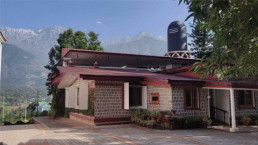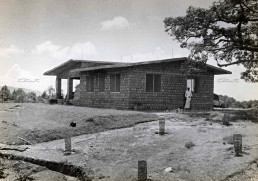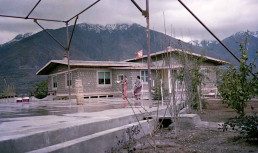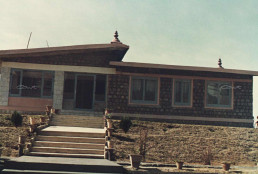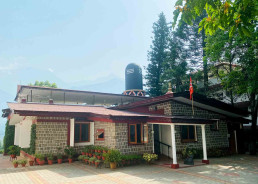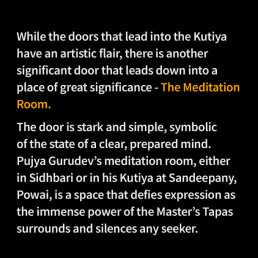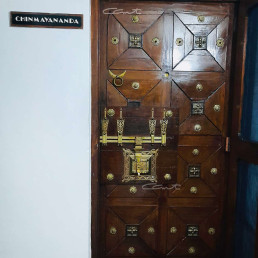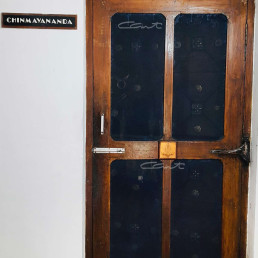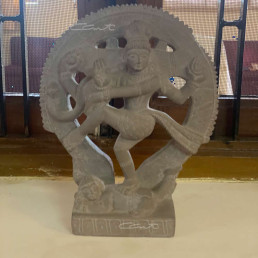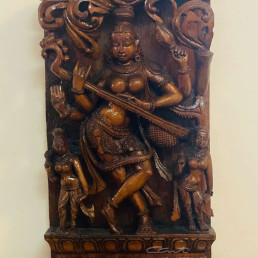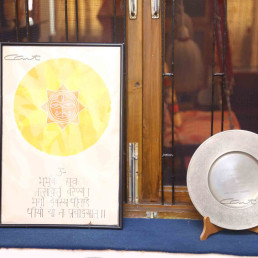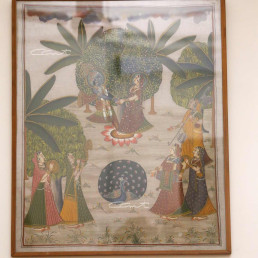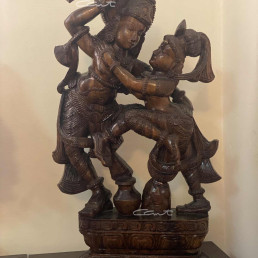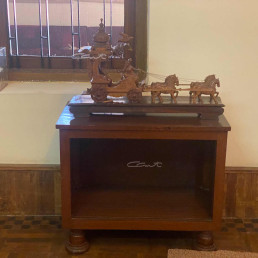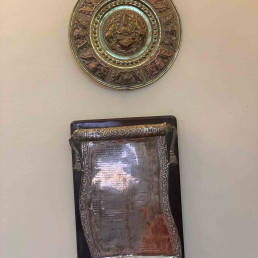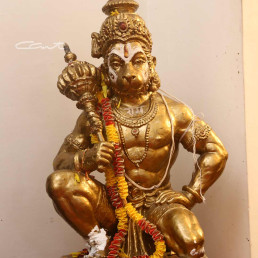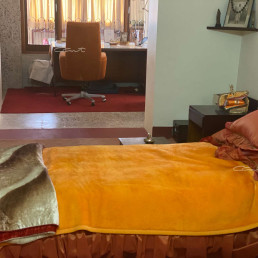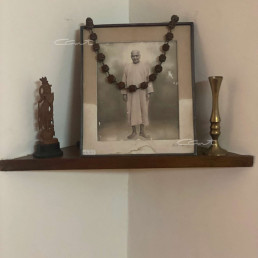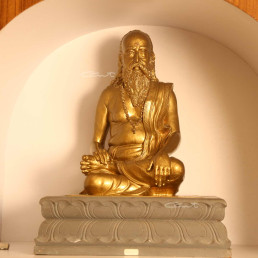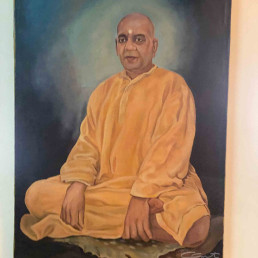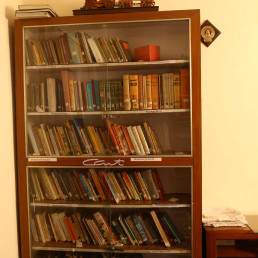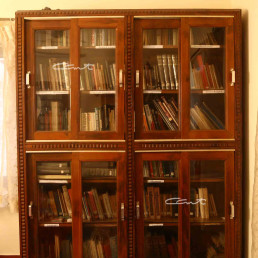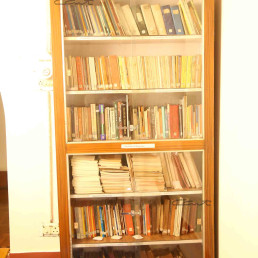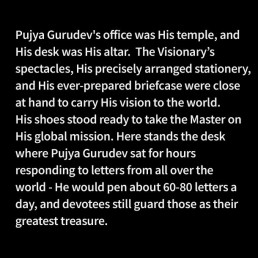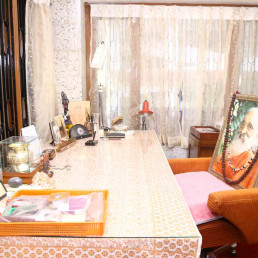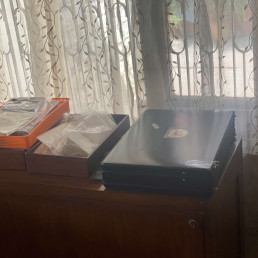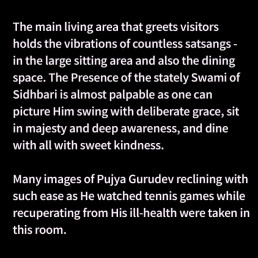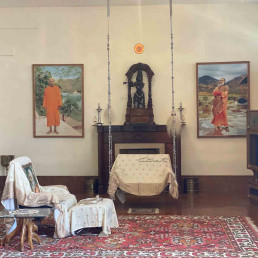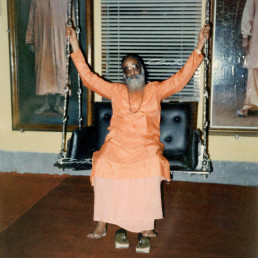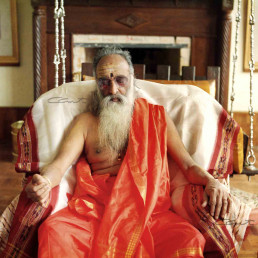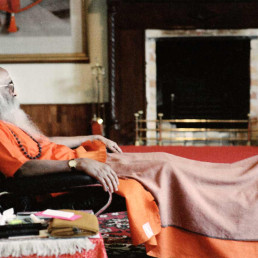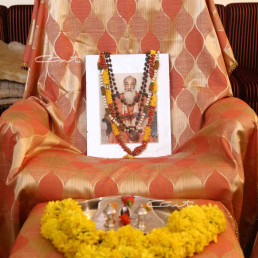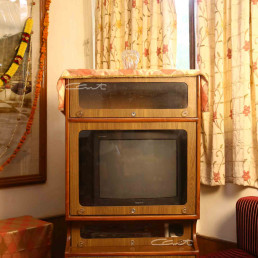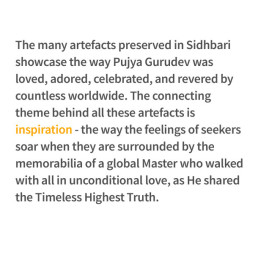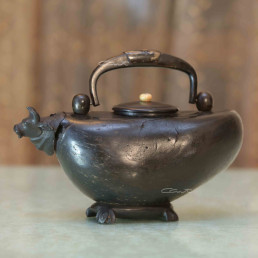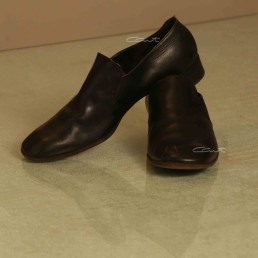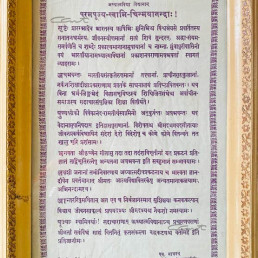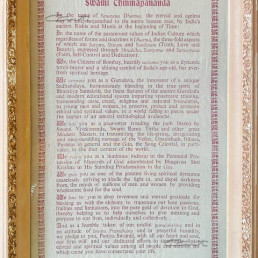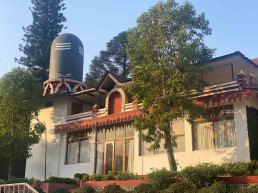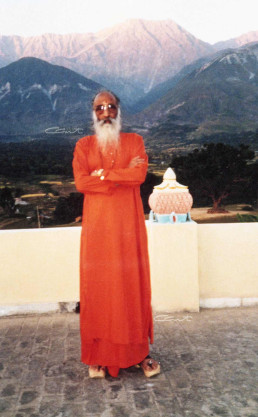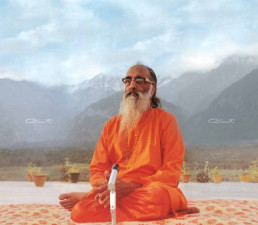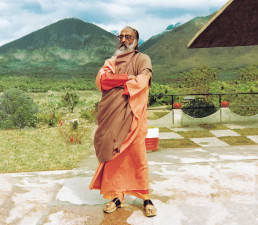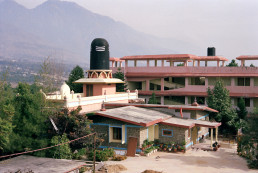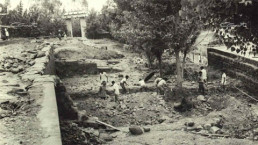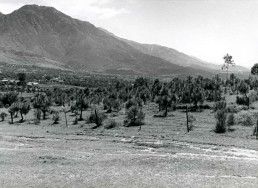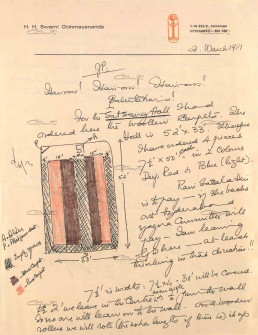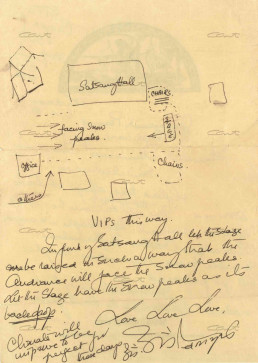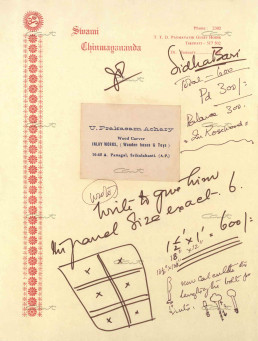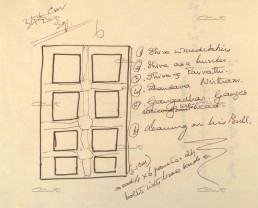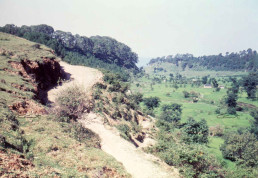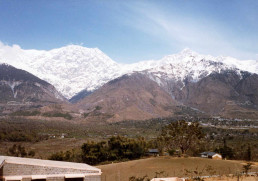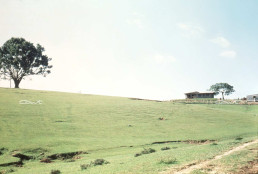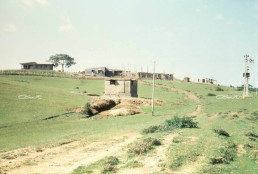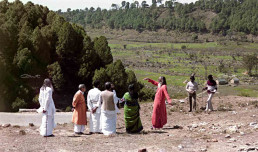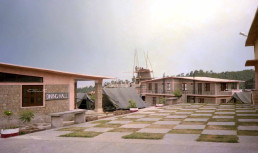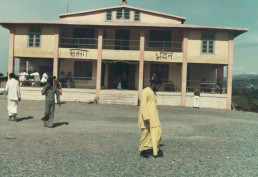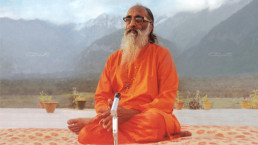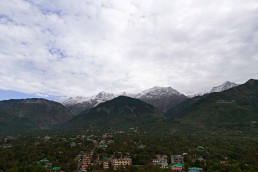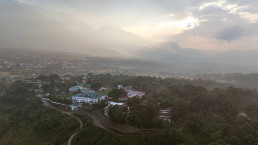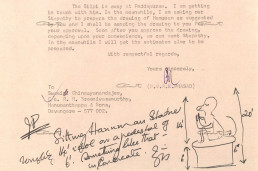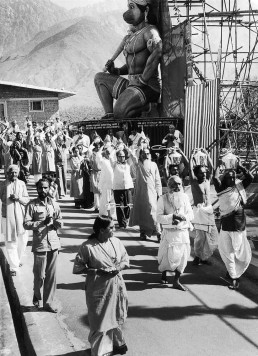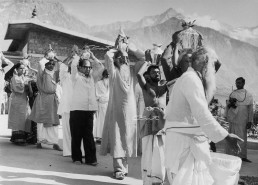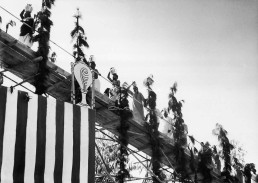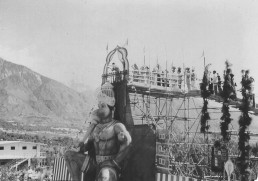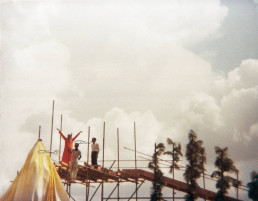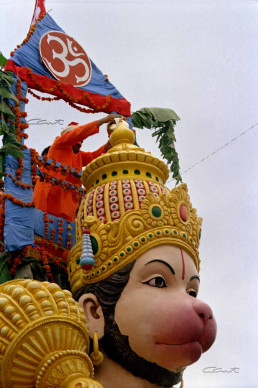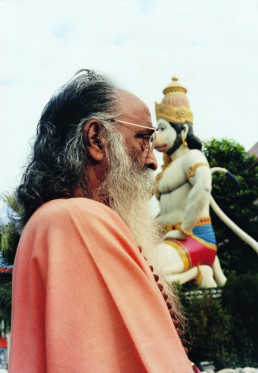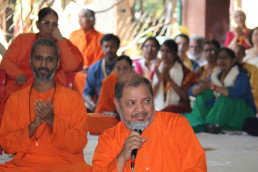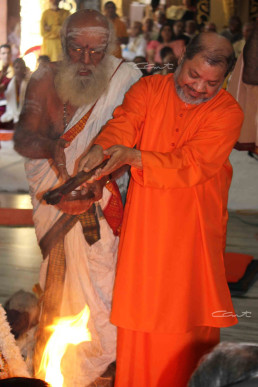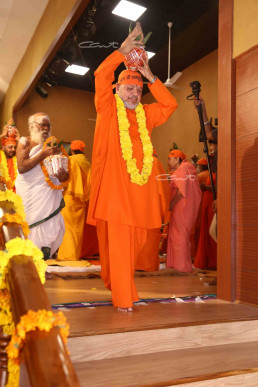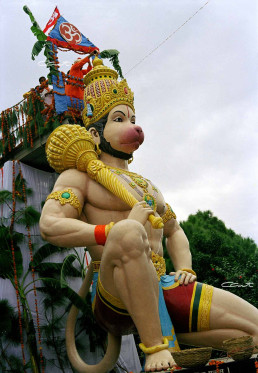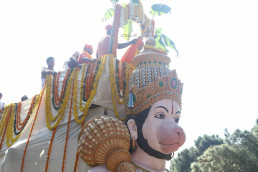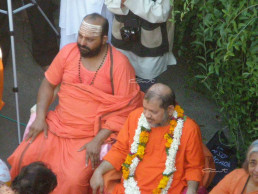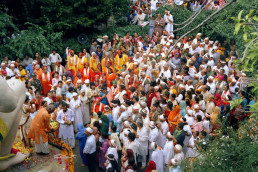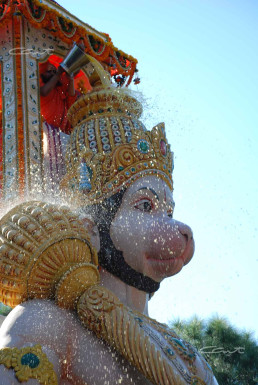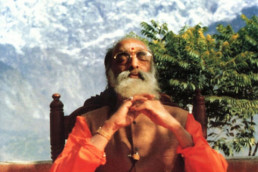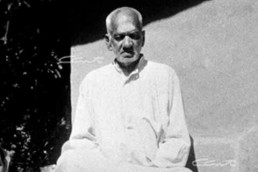Sidhbari Kutiya
Pujya Gurudev Swami Chinmayananda was truly at home anywhere He went. And for all devotees, His Kutiya in Chinmaya Tapovan Sidhbari is a special temple.
Pujya Gurudev’s Kutiya was one of the first buildings that came up on the desolate hillock of Sidhbari. With Dharamshala on the left and the Yol Cantonment on the right, its location is scenic. The mighty Dhauladhar mountains are a stunning backdrop. Indeed, today, when we enter Pujya Gurudev’s Kutiya, we feel at once the calming sense of being in the warm Presence of an extraordinary Guru. We can almost hear His powerful voice calling out in our hearts, “Hari Om!”
In 1976, Pujya Gurudev wrote to Colonel L.S. Pathania with an outline of his plans. That letter is shown below. He then carefully supervised the construction so that minimum resources were used.
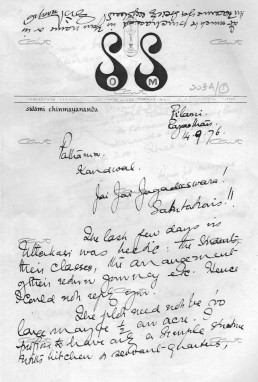

Photos of the Kutiya - Then to Now
The vibrant Presence of Pujya Gurudev and the accompanying deep silence is unmistakable in every room of the Kutiya, as it flows into our deeper consciousness. He also intended that the Kutiya would be more than just His place of residence in the Sidhbari ashram. The sitting cum dining hall was also the satsang hall where Gurudev gave so freely of Himself to transform countless lives. The dining area brings to our minds the warm memories of His loving appreciation, of course sweetened by His great sense of humour during countless bhikshas! When we stand in front of His Padukas in that satsang Hall, and gaze at the portraits of Parama Guru Swami Tapovanam and Him, waves of gratitude and respectful love floods us. The old television still preserved in that room reminds us of Pujya Gurudev reclining there watching tennis tournaments and tapes of Mahabharata and Srimad Bhagavatam while recuperating from setbacks in health. We are filled with wonder about His indomitable spirit full of life with His Vedanta-in-Tennis commentary during those challenging times.
When we look at His meticulous office desk with the stationery, we can visualize the kind, attentive face of Pujya Gurudev writing one of His letters that devotees still treasure. Truly, Pujya Gurudev’s office desk was His altar, and writing was His puja.

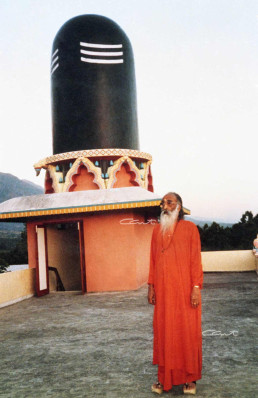
At the top of the kutiya, he had a Shiva Linga installed. In his own words: “The ellipse represents our cosmos. If that ellipse is half-buried what is seen on the surface is a Shiva Linga, which represents the manifested and therefore visible part of the Cosmos. This is then supported by the other half of the ellipse hidden from our vision.”
He then had the Nandi placed in front of the Kutiya, facing outward, and said: “A man who has emptied his vasanas is Shiva, and such a person, if he has to function in the world, the vehicle should be ever-ready!”
The entire Kutiya of Pujya Gurudev is an emblem of spiritual steadfastness, endless benevolence, and all-encompassing knowledge. It is a place of most treasured memories, where we feel so close to our dearest Pujya Gurudev. Pujya Swami Swaroopanandaji shares his thoughts below.
Pujya Gurudev’s Kutiya at Sidhbari holds deep meaning for devotees and spiritual seekers. In this section, we present important artefacts and images from that revered abode of the renowned Master.
In this section, we present important artefacts and images from that revered abode of the renowned Master.
As we mindfully “walk” through Gurudev’s Kutiya, let us invoke His Presence that inspires and transforms the very way we view the different parts of the home that call out “Hari Om!”
Doors to the Kutiya and the Meditation Room
Scroll horizontally to see photos or
click/touch to expand.
Visitors’ Room in Sidhbari
Pujya Gurudev’s Bedroom
Library Space
Office area and desk
Satsang Hall/Sitting and Dining Rooms
Artefacts
Kutiya Videos
Navigation
Next Topic
Sidhbari Kutiya
A focal point of Sidhbari, Pujya Gurudev’s Kutiya holds deep meaning for devotees and spiritual seekers. In this section, we present important artefacts and…
Home Page
Nothing found.
Previous Topic
Sidhbari Kutiya
A focal point of Sidhbari, Pujya Gurudev’s Kutiya holds deep meaning for devotees and spiritual seekers. In this section, we present important artefacts and…
The Preparation
Noble as the beginning was, it required labor, penance, and patience. Steadily, with Pujya Gurudev’s astute guidance at every step, the barren hillock in the Kangra valley slowly transformed into Chinmaya Tapovan, Sidhbari.
Pujya Gurudev’s resolve was divine, and His vision held clear conviction. Where everyone else saw a bald hill, Pujya Gurudev sighted great potential! Noble as the beginning was, it required labor, penance, and patience. In the tapas to procure the barren land from the government, a devotee Col. L.S. Pathania persevered, and soon the Chinmaya Tapovan Trust (CTT) was formed on March 24th, 1977 and registered under the Society Registration Act xx1 of 1860 with Sri Jagadeesh Prasad and a dedicated team to fulfill the noble purpose of spiritual learning and noble service. To commence construction, Bhoomi Puja was done on the auspicious Guru Poornima day of July 10th, 1979.

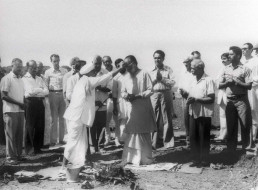

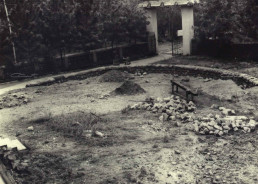
The initial years were full of challenges like poor road access, intermittent electricity, and difficulty with water supply; it was almost past the September of 1979 that work actually began onsite. Yet, when Pujya Gurudev voiced his sankalpa for the ashram inauguration to be on April 24th, 1981, his faith energized all to work together and complete construction of most of the initial buildings within 18 months despite two bitterly cold winters and heavy monsoon rains.
In the following years, infrastructure kept growing rapidly in the ashram. Every building that came up was carefully overseen by Pujya Gurudev. Devotees still speak in awe about His Yoga-in-Action when he was totally involved in the smallest detail but operated from a lofty undisturbed height.
In front of the Satsang Hall, Gurudev planned an open plaza for major events. “In front of Satsang Hall, let the stage be raised in such a way that the audience will face the snow peaks.”
The deep foresight in planning the best backdrop for the Satsang Hall along with an auspicious, intricately decorated entrance, the vigilant supervision of the Kutiya construction, the brilliant vision behind His sketch of Sidhbari Veera Hanumanji – His precision in anything was not just about physical perfection but a greater fulfillment.
Countless were such instances when devotees could see Gita teachings come alive in every step of Pujya Gurudev. The barren hillock in the Kangra valley slowly transformed into Chinmaya Tapovan, Sidhbari.
Navigation
Next Topic
The Preparation
Noble as the beginning was, it required labor, penance, and patience. But with Pujya Gurudev's astute guidance at every step the barren hillock in the Kangra…
Home Page
Nothing found.
Previous Topic
The Preparation
Noble as the beginning was, it required labor, penance, and patience. But with Pujya Gurudev's astute guidance at every step the barren hillock in the Kangra…
The Purpose
Pujya Gurudev had two clear aims for the ashram in Sidhbari. First, the essence of the scriptures must be spread among the Hindi-speaking people of the Himalayan region and North India. The second was to uplift the lives of the Pahadis, the natives of the Himalayan region, who had faithfully served the saints and sages in the mountains.
Parama Guru Swami Tapovan Maharaj had passed through the Kangra valley during his trek across the Kangra region. Walking in the footsteps of His beloved Guru many years later, Pujya Gurudev Swami Chinmayananda came to Sidhbari after finishing a yajna at Shimla in 1977. Instinctively tuning into its spiritual heritage, Pujya Gurudev could envision that Sidhbari would be home to Chinmaya Tapovan, a crest-jewel of Chinmaya Mission. Blessed by the ancient rishis and fit to be an apt spiritual legacy of Swami Tapovan Maharaj, the ashram at Sidhbari would be an offering of Chinmaya to Tapovan. There, the bliss of Knowledge (Chinmaya) would revel in a forest of penance (Tapovanam).
The time had also come for a greater debt to be repaid to the Pahadis who had served the sages and saints in the Himalayas for countless ages. Pujya Gurudev’s mission aimed to empower the people in the Himalayan valleys with the strengthening devotion of Tulsi Ramayana as well as the means to achieve healthier and economically better lives.
Pujya Gurudev knew that the work ahead may not be fully understood. In His words:
I am now turning my full attention to an aspect of the revival program which we had to seemingly neglect so far, as we had neither the leisure nor the required workers to serve the poor but noble people living in the interior villages of the Himalayas – the Pahadies; nor had we the workers for the Hindi areas.
I had been planning this for the last three years, scouting for the right place, discovering the required funds and building the campus for running the Sandeepany (HIM). In the Himachal Pradesh, in the rich Kangra Valley, just down below the famous Dharmsala, adjacent to the Yol Cantonment, we are now erecting a campus to accommodate 40 Brahmacharis to preach in the predominantly Hindi-speaking areas, and some 20 Brahmacharis to serve in the upper and interior areas of the Himalayas – from Kashmir to Almorah.
This is a gigantic work, amidst a people who cannot now see through our vision-oriented program, and so are at present, not so very enthusiastic about us and our work. That will not discourage us; and, we are sure we will soon catch their attention and compel their respectful admiration by the sheer benevolence of our services to their community.
The purpose was strong – to train a new generation who will carry the wisdom of Hindu Sanatana Dharma around the world. The promise was firm – the lives of the people of Himachal would be uplifted – materially and spiritually – through the grateful love nurtured by a global Master, a son of Sidhbari, Pujya Gurudev.
Chinmaya Tapovan Sidhbari would become the ashram of many blessings to the entire Himachal region and the world in the years to come.
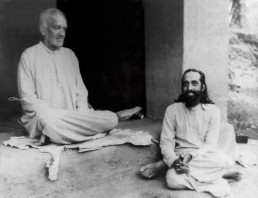

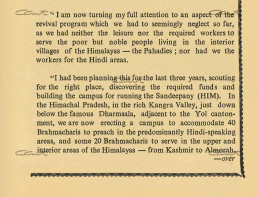
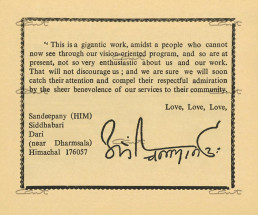
Navigation
Next Topic
The Purpose
Pujya Gurudev had two clear aims: first, to spread the essence of the scriptures among the Hindi-speaking people of the Himalayan region and North India and…
Home Page
Nothing found.
Previous Topic
The Purpose
Pujya Gurudev had two clear aims: first, to spread the essence of the scriptures among the Hindi-speaking people of the Himalayan region and North India and…
The Place
Sidhbari means the abode of Siddha Purushas (the spiritually enlightened). Nestled in the Dhauladhar mountains, Sidhbari in Himachal Pradesh, India, holds a special place in the heads and hearts of Chinmaya Mission devotees worldwide.
Sidhbari
Sidhbari, the abode of Siddhas, is a place of sacred significance, holding a special place in the history of Chinmaya Mission. Located in India’s Himachal Pradesh, Kangra District, about 7 kilometers away from Dharamsala, it is home to Chinmaya Tapovan and is the site of Sandeepany HIM (Sandeepany Himalayas). Named with great reverence by Pujya Gurudev in honor of Parama Guru Swami Tapovan Maharaj, the ashram in Sidhbari is a place where penance and devotion shine.
The very mention of Sidhbari redirects all our senses to serene sanctity. The divine land, Deva Bhoomi, where the sage Kapila Muni had spent some time in contemplation and imparted the Highest Knowledge with great love for His mother Devahuti evokes reverence.
The air feels ripe with peace from the deep meditation of many sages in ancient ages. The breathtakingly beautiful Dhauladhar mountains, the terraced paddy fields nourished by the gurgling streams, and the rich green of the pine forests transport us to a realm of deep wonder. The play of sun, snow, and clouds in the Kangra Valley mesmerize and usher in a fullness beyond words. It is this Sidhbari in Himachal Pradesh, India, that holds a special place in the heads and hearts of Chinmaya Mission devotees worldwide.
Getting there
CONTACT
Sandeepany (HIM)
Sidhbari 176 057
Himachal Pradesh, India
Ph: +91-1892-234 324
Fax: +91-1892-236 199
Email: ctt@chinmayamission.com
DIRECTIONS
Sidhbari Videos
Navigation
Next Topic
The Place
Nestled in the Dhauladhar mountains, Sidhbari in Himachal Pradesh, India, holds a special place in the heads and hearts of the devotees at Chinmaya Mission…
Home Page
Nothing found.
Previous Topic
The Place
Nestled in the Dhauladhar mountains, Sidhbari in Himachal Pradesh, India, holds a special place in the heads and hearts of the devotees at Chinmaya Mission…
Hanuman Mastakabhishekam

Introduction
Awe-inspiring, alert, and magnificent, Vayuputra Shri Hanuman is a powerful presence in the Chinmaya ashram at Sidhbari. Calming the gusty winds across an open landscape with His powerful yet compassionate glance, the majestic Lord sits in veerasana ready to serve both Shri Ram whom He holds in His heart and the devotees who adore and approach Him.
It was the vision of Pujya Gurudev Swami Chinmayananda that sketched the arrival of the 22-feet idol of Shri Hanumanji at Sidhbari. Seeing how the fertile land of Sidhbari stood bare because of the strong winds, Pujya Gurudev invoked the Presence of Vayuputra Hanuman. His simple sketch in a letter (1981) to a longtime devotee marked the birth of the 16-feet towering idol atop a 6-feet pedestal. Gurudev knew – where the son will be, the Wind-God father will move with gentle affection! Thus was invited Vayuputra Shri Hanuman to watch over the Sidhbari ashram as construction progressed smoothly.
Facts
CONSECRATION
October 10th, 1982
DESIGN
Initial sketch by Pujya Gurudev
Prototype and Sculpture by Shri Kashinath Shilpi
Statue: 16-feet
Granite Base: 6-feet
NOTES
Verses from Tulsi Ramayana selected by Pujya Guruji adorn the granite base.
Over 5,000 attended the first Mastakabhishekam.
HISTORY
Every five years, a Mastakabhishekam is performed to Lord Hanuman at Sidhbari. Below is a brief chronicle of this momentous event over time.
In 1982, when Shri K. Kashinath Shilpi had completed the construction of the idol (here is a transcript of the interview with Shri Kashinath), Pujya Gurudev planned the first Mastakabhishekam to consecrate and invoke the power of Lord Hanuman into the beautiful idol seated under the open skies according to Vedic traditions. To perform an abhishekam (the divine bathing ceremony) from the crown to feet of the towering idol that rose about 22 feet, a ramp that extended over 90 feet from the ground to the top was erected by the army personnel of Yol Cantonment. It was decorated by pine tree branches carefully picked with devotion and reverence to Nature. The energetic Chyks from Chennai led by Swami Siddhananda were a great help in this inaugural consecration.
The rituals began on October 8, 1982. As the Vedic vibrations filled the air, Pujya Gurudev guided all devotees to a continued chanting, “Om Sri Ramadhootaya Namaha.” Br. Vivek Chaitanya (now Swami Tejomayananda) added the melody of devotion inspiring them to also sing the Hanuman Chalisa. When lightning and thunderous rains filled the skies two days before the abhishekam, Pujya Gurudev Swami Chinmayananda remarked: Perhaps Varuna and Indra wanted to do the abhishekam first and give their benediction!
October 9 was a pious day of homams and kalasa sthapana. Thousand and one kalasas (pots) in gold, silver, brass, stainless steel, copper, mud filled with either water from Ganga or milk, curd, turmeric or sindhoor were divinized with invocations and worship (Aavaahanam and Sahasra Archana). As those rituals concluded, Sri Hanumanji’s idol was unveiled that evening after Arati.
When October 10th dawned, the Mastakabhishekam drew about five thousand people worldwide, including army personnel, government officers, and joyful people from the villages that surrounded the beautiful Sidhbari. As the priests followed by Pujya Gurudev, dignitaries, and devotees walked up the ramp with the sanctified Kalasas to perform the abhishekam, bathing Lord Hanuman’s form from crown to foot, the entire gathering was immersed in devotion with reverential chanting. Worship (Archana) with adornment (Alankara) and arati culminated with a long vada mala offered to the newly consecrated lustrous Lord; Vayuputra Hanuman stood blessing all of Sidhbari.
That first abhishekam on October 10, 1982, marked the onset of the 5-year tradition surrounding Shri Hanumanji at Sidhbari.
With the holy waters from the Ganga of Haridwar, the Kalasas were anointed as the homam rituals again purified the air to mark the 5-year milestone after the first consecration of the Sidhbari Vayuputra. It was a heartwarming sight to watch Pujya Gurudev Swami Chinmayananda race up the ramp which was built by the local villagers.
Pujya Gurudev led the Abhishekam procession energized by the sonorous chants of “Om Sri Ramadutaya Namaha.” Fireworks lit up the skies as the procession moved from the idol of the greatest Sevak Hanumanji to also perform the Abhishekam of His Master, the Supreme Lord Vanavasi Rama and Mother Sita at the Rama Mandir in Sidhbari.
This was the last Mastakabhishekam performed by Pujya Gurudev before His mahasamadhi in 1993.
Held a day after the memorable Vivekachoodamani camp of Pujya Gurudev, the third Mastakabhishekam was marked by elaborate preparations and excellent support by an earnest group of army personnel from the Yol cantonment who had erected an iron ramp and railing for the abhishekam. A sacred ceremony of Kalasa sthapana was followed by another hallowed reconsecration ceremony that filled hearts with grateful devotion toward the imposing guardian Lord of Sidhbari.
Set inside a beautiful mantap, 390 kalasas were brimming with the holy waters from the Manasarovar to the southern rivers and seas. Vedic scholars from Delhi (led by Sri Subbarama Shastri) initiated the ceremony with elaborate homams and performed puja to those kalasas. Notable were the three Pradhana Kalasas – for Lord Rama, Lord Hanuman, and one honoring Pujya Gurudev Swami Chinmayananda who had attained Mahasamadhi in 1993. When Pujya Guruji Swami Tejomayananda and other acharyas offered abhishekam with the sanctified waters, it was as though Tejasvi Hanuman was beaming down on the hundreds of devotees. As Hanumanji glowed even more in the Arati after vastra (new clothes) and garlands were offered, a gentle rain from the skies seemed to carry the joy of the heavens down to Sidhbari.
The skies over Sidhbari poured in anticipation, two days before the 5th mastakabhishekam in 2002. On the day of the abhishekam, priests carried the three Pradhana Kalasas from Kamala Hall while Pujya Guruji Swami Tejomayananda and the acharyas held the kalasas on their heads and performed the Mastakabhishekam amid devoted, enthusiastic chanting of Om Sri Ramadutaya Namaha. Later, as the face of Shri Hanuman shone in the Arati, the sun smiled between the parting clouds as if joining the celebration to delight all.
After gaining inspiration from Pujya Guruji’s camp on Hanuman Chalisa, the silver jubilee Mastakabhishekam started off melodiously with a musical concert by Pandit Jasraj. Then began the Vedic preparatory rituals of pujas and homams under the leadership of Shri Subbarama Shastri as four Pradhana Kalashas ready to be specially offered to Sri Rama, Lord Shiva, Lord Hanuman, and Pujya Gurudev adorned the top of the pyramid of 1000 kalasas.
Everyone wanted to offer their best to Shri Hanumanji – the Indian Army built a special ramp with much devotion; specialists from Brindavan, at Swamini Gurupriyananda’s request, decorated the place with flowers. When Pujya Guruji led the Mastakabhishekam procession in an atmosphere of fervent chanting and joyful Pahadi Bhajans, Shri Hanumanji’s face reflected the joy of His devotees. The special offerings of garlands, tulsi mala, angavastram, silver anklets, and a gold-embossed red belt with “Sri Ram Jay Ram ” lettered on it added the festive silver touch to the glowing Lord.
Keeping with the Vedic traditions, the 7th reconsecration ceremony was performed with great devotion and delight under the leadership of Pujya Guruji. The faithful gathering of villagers, army personnel, and devotees gazed on at the mesmerizing form of the mighty Shri Hanumanji during the Mastakabhishekam. When beautiful flower petals were showered on the huge form of the Lord after the ceremony, all hearts were bathed in great happiness.
In 2017, Mukhya Swami Swaroopananda performed the 8th Mastakabhishekam in the presence of Pujya Guruji Swami Tejomayananda.Once again, the unbroken chanting of “Om Sri Ramadutaya Namaha” and Anjaneya Sahasranama Archana sanctified the air as kalasa pujas and homams were performed by Sri Subbarama Shastri and his team. The abhishekam, as always, transported everyone who witnessed it into a realm of deep devotion that was colored with great joy when beautiful flowers were showered on Shri Vayuputra! The Lord continued to shine with new clothes, fragrant garlands, and a long pearl necklace that gained beauty because of adorning His luminous Form. It was a spectacular ceremony, and we present highlights of that 2017 consecration event.
The ninth Mastakabhishekam of Sri Veera Hanuman at Sidhbari was conducted in a memorable ceremony that spanned the days of Oct.8-10, 2022. The celebratory worship began on Oct.8 with great prayers offered during the Anjaneya Utsava Murthy puja. The eyes and hearts of all devotees were riveted on the resplendent idol of Shri Hanuman throughout the beautiful abhishekam as Swami Sharadananda conducted the elaborate puja. Following that, the Guru Puja at Pujya Gurudev’s Samadhi Sthal and the Guru Anugnya paada pujas of Pujya Guruji and Pujya Swami Swaroopanandaji indicated how the Grace of the Chinmaya Guru Parampara would be the guiding force for this Mastakabhishekam.
During the Kalasha Sthapana rituals, the colorful backdrop of the ceremonial pots signifying the five elements of space, air, fire, water, and earth was meaningful and eye-catching. The Vedic homams culminating with the purnahuti, and the rituals of Sri Rama Sahasranama Archana and Sri Hanuman Sahasranama Archana purified and permeated the entire surroundings in the ashram setting the stage for a grand Mastakabhishekam. On the chill and misty morning of Oct.10th, when Pujya Guruji and Pujya Swami Swaroopanandaji performed the Mastakabhishekam of the majestic Lord Hanuman with Panchamruta, turmeric and kumkum waters, all devotees onsite and online were moved by the divine beauty of the reconsecration ceremony in the scenic Sidhbari. Melodious bhajans by Pujya Guruji, Swamins, students of the 18th Vedanta course, devotees, and the Pahadi people added joy. The happy Garbha dances that brought people from far and near together added the sweet touch of happiness. Then, as the long line of devotees performing the abhishekam ended, the glowing idol of Vayuputra Hanuman was adorned with a beautiful garland and a bright saffron angavastram. When the festivities ended with Sri Hanuman Arati, it was evident that the 9th Mastakabhishekam had bathed and blessed all who witnessed it with joyful, grateful devotion.
Mastakabhishekam Videos
Related Topics
Related Topics
Nothing found.
Sidhbari, Hanumanji, and Gurudev
The Sankalpa for Sidhbari
Sidhbari means the abode of Siddha Purushas (the spiritually enlightened). Sidhbari is a place of sacred significance, holding a special place in the history of Chinmaya Mission. Located in India’s Himachal Pradesh, Kangra District, about 7 kilometers away from Dharamsala, it is home to Chinmaya Tapovan and is the site of Sandeepany HIM (Sandeepany Himalayas). Named with great reverence by Pujya Gurudev in honor of Parama Guru Swami Tapovan Maharaj, the ashram in Sidhbari is a place where penance and devotion shine.
The story of how Sidhbari, Pujya Gurudev, and Hanumanji came together is a story of persistence, penance, harmony, and devotion. When He recognized the spiritual aura of Sidhbari and had the divine sankalpa to build an ashram there, the obstacles were many. Even the locals of Sidhbari, in order to protect nature, resisted new development and newcomers at the time. With the help of Col. L.S. Pathania, the land was procured on a 99-year lease, which only recently, thanks to the efforts of Svargiya Swami Subodhananda (1958-2020), has been registered as a Chinmaya Mission property.
With the site purchased, the next challenge was the forceful gales of winds and heavy rains. The land was barren as strong winds uprooted vegetation, and heavy rains caused boulders to come hurtling down from the mountains. Slates of rock and piles of sand brought in for construction would be thrown around and blown away overnight. No high-rise building could even be attempted in the windy, high altitude among the mountains and open land. As Pujya Gurudev observed this hurdle, he declared and invoked, “Let Vayuputra Hanuman be here.”
Shri Hanuman - Victory and Worship
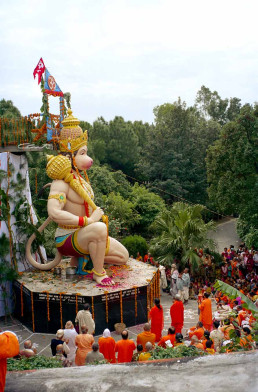
The son of Wind-God would be gigantic. As the Tejasvi Amshavatara, the son of Lord Shiva born in Mother Anjana’s womb through Vayu as His instrument, the Vayuputra had to be there to serve and support future growth. Though He held His mace (gadha) with powerful grace, He would kneel in devotion, ready to serve His Lord Rama who would arrive in the ashram a few years later! As Hanumanji took form in Sidhbari, the winds grew calmer, and the land rejoiced with lush fertile growth.
Here is a transcript of the interview with Shri Kashinath Shilpi and his crew who came to sculpt the splendid Shri Hanumanji. After the Vayuputra idol was completed and stood victorious in Sidhbari, divinity manifested all around in the structures built. The massive Shivalingam that crowned Pujya Gurudev’s kutiya signaled auspiciousness all around, and the idol of Nandi in front of the kutiya was the ready vehicle for service.
It was important to offer gratitude and worship to the supreme sevak, Sri Pavanaputra Hanuman. So, in 1982, Pujya Gurudev inaugurated the tradition of the once-in-five years Mastakabhishekam in Sidhbari. Pujya Gurudev wanted the whole of Sidhbari to rejoice and pray as the lustrous 16-ft Hanumanji atop the 6-ft pedestal would be consecrated with Panchamruta Abhishekam from crown to feet. The army personnel who lived in the Yol Cantonment nearby offered their service to construct a massive ramp to lead up to the top of the idol. Here is the timeline with key details of the Mastakabhishekams that have continued since 1982.
The 9th Mastakabhishekam ceremony at Sidhbari, is being held on October 10th, 2022, and the traditional festivities that have become a time of joyful worship at Chinmaya Tapovan, Sidhbari, are already under way.
The son and sage of Sidhbari

The spiritual aura of Sidhbari and the love of the simple-hearted natives that embraced Pujya Gurudev made Him the celebrated son of Sidhbari. After being spiritually born as Swami Chinmayananda in the Himalayas, Pujya Gurudev carried the essence of Hinduism and Vedanta around the world, making Sidhbari a memorable part of His mission. Even as He belonged everywhere, there was a deep connection with the pristine and spiritual environment at Sidhbari. Pujya Gurudev could cajole and command the elemental forces there. Many have witnessed how Pujya Gurudev would signal threatening rain clouds to retreat until pujas under the open skies were completed. A lit lamp would stay aflame and not be extinguished by the winds in Sidhbari, a glowing evidence of His harmonious relationship with Mother Nature! When Pujya Gurudev stood with His hands folded across His chest against the backdrop of the picturesque Dhauladhar mountains, the intimate connection of Him with the divine land was strikingly evident. It was that love for and from Himalayas that finally cradled Him in His Samadhi Sthal in 1993.
Truly, the sacred space in Sidhbari holds many blessings that uplift and transport seekers to a soul-stirring, quiet fullness. In this digital pilgrimage to that hallowed Chinmaya Tapovan, we pause to visit Pujya Gurudev’s Kutiya and worship the Guru who brought us those great blessings which we continue to discover.
Related Topics
Related Topics
Nothing found.
Interview with Shilpi
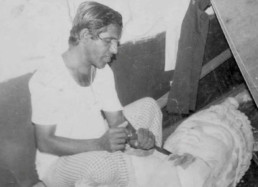
The Sculptor
Shri Kashinath Shilpi
Shri Kashinath Shilpi, a renowned sculptor from Karnataka (India), was identified by Pujya Gurudev to sculpt the magnificent idol of Shri Vayuputra Hanuman at Sidhbari. He was recommended by Swami Brahmananda. Here is a transcript of the interview where Shri Shilpiji shared his recollections of that memorable time.
Please share about your experience in making this Vigraha.
After seeing the clay model made by me, Swamiji (Pujya Gurudev) told me, “I will come after 3 months. Vigraha should be beautiful.” Then I went with my brother and other workers and started the work with great joy. The weather was quite pleasant.
After 3 months, Swamiji returned to Sidhbari after completing His world tour. He saw the idol which was in progress. We were engrossed in our work. Swamiji was extremely happy about the idol; saying “You have brought out the Akruti (beautiful appearance) exactly like what was in my mind!” He took out a costly shawl (valued about Re 10,000) and honoured me by draping it on my shoulders. He also hugged me with great joy.
After resting, Swamiji came the next day. He called out my name thrice: “Kashinath, Kashinath, Kashinath!” Being so absorbed in work, I failed to respond. Later, in His discourse, Swamiji described how I didn’t respond even after being called by name 3 times. He remarked, “Learn Ekagrata in work from Kashinath.” On my part, I felt very bad for not responding to Swamiji.
How did you get in touch with Chinmaya Mission?
I became associated with Chinmaya Mission through my brother and Brahmaji (Swami Brahmananda, Chinmaya Mission Bengaluru).
How many Shilpis did you need to make this Murthi? Did you take the help of Shilpis there (at Sidhbari)?
I went from Shimoga with my brother Narayana and two other members. We took the assistance of 6 labourers there. They helped us a lot till the end.
How did they provide the required materials for making this Hanuman Murthi? Did you encounter any obstacles in getting the required materials?
I didn’t find any obstacles in getting the required materials. They used to take me to the city for the selection of materials. We searched many places to get the right materials.
What led to your first meeting with Swamiji?
Brahmaji had asked my brother to draw a picture of Swamiji. It came out very well. Brahmaji told my brother that Swamiji wanted to build a Gopuram and make some Vigrahas (idols) including Hanumanji in Sidhbari. “Let’s go and meet Swamiji.”
Have you made any gigantic Vigraha earlier before making this Hanuman Murthi?
No. Hanumanji Vigraha in Sidhbari was the first Vigraha of that size that I made in my life then.
Can you describe your first travel experience to Sidhbari?
Brahmaji told me that Swamiji is coming to Sidhbari. “Let’s go and meet Swamiji.” We didn’t get tickets from Bangalore. Brahmaji said that we will try for tickets from Chennai; however, we could not get tickets from Chennai too. Then I travelled with Brahmaji in a general compartment without reservation to Delhi and from there, we went by bus. It was a very strenuous journey. With great difficulty, we reached Sidhbari.
Did Swamiji give you any guidance in the form of a sketch or model before making the Hanuman Murthi ?
Swamiji showed me a photo of Hanumanji and asked me to make the Murthi accordingly. Then, looking at my short stature, when Swamiji had a doubt whether I could execute His vision, Brahmaji assured Swamiji that I was a great artist and could make the Murthi. Then Swamiji asked me to make a model and show. So, I made a 1.5 ft clay model of Hanumanji Murthi and showed it to Swamiji. Swamiji was happy with the model and asked me to start the work. Then Swamiji left for His world tour.
You said that Swami Chinmayanandaji was extremely happy with the Hanumanji Murthi made by you. Did He give you any memento?
I recall how all the materials including paints for finishing this Hanuman Murthi were provided. Hanumanji’s Murthi came out beautifully with the painting that my brother Narayana and I had done.
Then, when the consecration of the Hanumanji Vigraha was performed with sacred water in 108 silver Kalasas, my brother Narayana and I were also given the silver pots to perform the Mastakabhisheka. We went to return the kalasas after performing abhishekam. It was then that Swamiji asked us to keep the silver Kalasas we used as mementos.
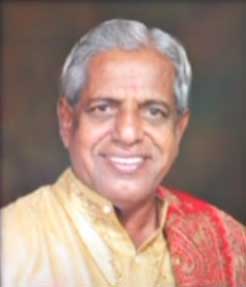

Sidhbari Intro
Invoking Gurudev's Grace, we attempt to highlight the beautiful landmarks and special events at Sidhbari that enrich Chinmaya Mission worldwide.
In this module, we attempt with a prayer to highlight the beautiful landmarks and special events at Sidhbari that enrich Chinmaya Mission worldwide.
THE SANKALPA
Sidhbari, Hanumanji, and Gurudev
The story of how Sidhbari, Pujya Gurudev, and Hanumanji came together is a story of persistence, penance, harmony, and devotion. When He recognized the spiritual aura of Sidhbari and had the divine sankalpa to build an ashram there, the obstacles were many.
VAYUPUTRA
Hanuman Mastakabhishekam
It was the vision of Pujya Gurudev that sketched the arrival of the 22-feet idol of Shri Hanumanji at Sidhbari. Seeing how the fertile land of Sidhbari stood bare due to the strong winds, Pujya Gurudev invoked the Presence of Vayuputra Hanuman.
THE ABODE
Gurudev's Kutiya
A focal point of Sidhbari, Pujya Gurudev’s Kutiya holds deep meaning for devotees and spiritual seekers. In this section, we present important artefacts and images from that revered abode of the renowned Master.
A Treasure Trove
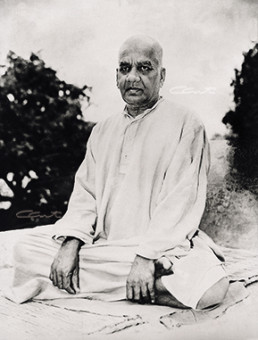
Editor's note
Just as the magazine was getting ready to go to the press, I received a surprise call from Brni. Prarthana Chaitanya (Now Swamini Kaivalyananda). She had discovered some letters by Swami Tapovan Maharaj! Two of them were written to Swami Mahadevavanam, a disciple of Swami Tapovanam, and of the other two, one was dictated by Swami Tapovan Maharaj and put on paper by Sri Chandrasekhara Menon, while the other was a copy of an inspiring letter by Swami Tapovanji. All four letters in Malayalam were preserved carefully by Dr. Geetha, niece of Swami Mahadevavanam, and handed over to Brni. Prarthana Chaitanya for the Chinmaya Mission archives.
Once again, the Chidambarams, the devoted doctor couple in Chennai, came to my rescue and helped with the English translation. Here are some extracts from Swami Mahadevavanam’s letters and the entire letter dictated by Swami Tapovanam, along with the scanned copy of the originals, for indeed, the beauty of the original can never be fully captured in English.
Letters from Swami Tapovanam
This letter from Swami Tapovan Maharaj dated 20-7-1952, was written to Swami Mahadevavanam from Gangotri
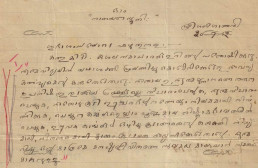
SCANNED EXCERPT
It should be considered as an essential duty to practise Atma Vidya according to one’s capacity. One should reflect on scriptural works and the Upanishads which give us knowledge of the Self. Contemplate on the Self. Along with that make it a daily practice to worship the Lord also. Whatever actions you undertake, should be performed with complete selflessness. These should be considered unavoidable and practised daily, continuously, without any break. Atma Vidya alone is capable of making a person completely happy.
Swami Tapovan Maharaj
Letter from Swami Tapovan Maharaj dated 16-9-1952, written to Swami Mahadevavanam from Uttarkashi
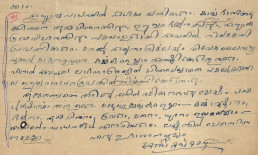
SCANNED EXCERPT
One should put in more effort in Atma-sadhana. Along with one’s other duties, one should create time for contemplation on the Self, worship of the Lord and study and reflection on the scriptures. Till the mind becomes absolutely pure and full of discrimination and dispassion, one should perform all one’s duties. However, without worrying about the gains or losses accrued through them, one should perform them with equanimity of mind in the attitude of worship of the Lord.
Moksha (liberation) is knowing the Atma-tattva and revelling in it. That is the highest goal of life (parama-purushartha). All the other sadhanas like performing selfless actions, worship of the Lord, contemplation on the Self, sravana, manana, dhyana etc. are the means for that. After all, one has to reach the goal!
Swami Tapovan Maharaj
Letter dictated by Swami Tapovan Maharaj to Pallathil Chandrasekhara Menon, at Gangotri.


SCANNED EXCERPT
Narayana Smaranam!
The first step in spiritual life is the clear knowledge and firm conviction that God alone is true, infinite and the very form of bliss. One who firmly believes in this does not have any attachment to external things or any desire for enjoyment arising from them. If not sense pleasures, people continually crave for pleasures associated with the ego. They revel in the temporary joy born of thoughts like “I am very rich, I am a great leader, I am a great scholar, I am a great devotee, I am a great jnani…” and consider themselves fulfilled. Even great people who have renounced all kinds of worldly pleasures forget their goal because of their desire for these egocentric pleasures. Pleasures arising out of sense objects and indulgence in the ego will perish in a moment and result in great sorrow. Divine happiness arising out of remembrance of the Lord (ishwara-smaranam) alone is untouched by sorrow. Since God is eternal, the happiness arising out of Him is also eternal and has no association with sorrow. Those who have the discrimination to know this, revel in the constant remembrance of the Lord and not in anything else. Through remembrance of the Lord, they purify not only themselves, but the entire world. For an asthika (one who firmly believes in the existence of God) there is no greater service to the world than the service through the remembrance of the Lord. All other kinds of service are inferior to this. So, do the sadhana of ishwara smaranam without a break.
Swami Tapovan Maharaj

Param Pujya Swami Tapovan Maharaj – Seated erect even in his last days.
Previous Topic
Nothing found.
Next Topic
Nothing found.
Home Page
Nothing found.
Monk and the Dacoit
By V. PANOLY
The way to mount Kailas was long and lonely; it was touched by eternal silence. The rough path, seldom trodden by human feet, was winding through relentless rocky stones that often disturbed the skin of the bare foot. The quiet regions which are not frequented by worldly men are often visited by monks and sadhus. One day, through this lonely region, a monk was going for the darshan of Mt. Kailas. He walked and walked, till the rays of the sun fell perpendicular on his bare head. There was a combined attack on the skin of his bare feet by the uncompromising rocky path underneath and the penetrating rays of the sun from above. But the monk knew nothing of these, for his flesh was not weak, nor was he under its sway. He tirelessly traversed until all his nerves got heated and disarranged on account of the non-stop march to the horizon. But did he feel all these? No, he knew naught; he was walking beyond time. He walked, and walked again, till his throat became dry and lips parched. Still he did not lose balance. How strange! Anyone else would have fallen down and broken into pieces in such circumstances. But he did not, for he had such an unflinching faith in the Lord – a faith that could move even mountains.
He stopped and looked around. There was no trace of mankind anywhere within the reach of his eyes. He was a wandering monk, and in this barren region, which men did not generally frequent, whom should he ask for food or help or shelter? He stopped abruptly as if he had a flashing darshan of the Lord in front of him, and in a mild, but compelling tone, he said, “O Lord, mercy is Thy name and Thou hast shown this, Thy devotee, Thy boundless mercy, often unasked. Thou hast fed this sevak of Thine through unknown hands and made his parched lips move even in deserts, and this humble self, sevak of Thy sevaks, becomes speechless when he ponders on Thy mysterious and amazing ways. Hah! Soul of my soul, mercy incarnate, how wilt Thou save this child of Thine, here and now, for his body is fading and falling, while his energy bids farewell to him.”
He had preached often to his devotees about the ineffable mercy of the Lord, for he himself had felt it beyond all doubts. Besides, the shruti (Vedas) also proclaims that ‘the Lord sees without eyes and hears without ears’. So he was sure that every word his lips uttered would reach God and He would come to his succour. His body was fatigued due to hunger. But who will offer him food in that silent abode of snow, devoid of human habitation? “Hah! Lord, how wilt Thou save Thy child here and now,” came again the sigh from him.
“Halt,” someone cried from behind. He halted and looked back. A form concealed in a thick blanket was steadily and quickly moving towards him. Wah! Is God appearing in the guise of a bhikshu to help him? Or is it only an illusion? The form in the thick blanket paced quickly. He had a beard as all sadhus generally have in that region of mountains and from within the covering of the blanket, the faint colour of geruva cloth (kashaya) was also visible. Is he a bhikshu? No, he cannot be a bhikshu, for his look was dreadful. And more dreadful than his look, was the sight of the dagger he held in his hand. Who is he? None other than a dacoit! He had been chasing this monk from a long distance. He was a specialist in cheating and his chosen hobby was to rob sadhus and saints, monks and mendicants of course, not of their spiritual wealth. Had he attempted it, he would not have continued to exist as a dacoit for long! He used to watch from a convenient spot pilgrims moving through the region of mountains and he used to make hay, not when the sun shines, but when the sun sets because by that time the yatris would be retiring somewhere, and he would conduct a wild raid in all the camps with the natural cooperation of darkness that would stretch its helping hand to him even unasked. But with this solitary traveller, he played his game in the open daylight, exhibiting no patience for the sun to set or the night to come. Here the monk was going alone, and so, without losing time, he chased him.
At a convenient spot, the monk stopped, and the dacoit also stopped. The ferocity in the face of the dacoit was sharper than that of the dagger’s shining edge.” Hah! Lord, how dost Thou save this, Thy sevak, here and now in this mountainous region, cut away from all human habitation, when his body is fading and falling due to hunger and tedium!” With this prayer, the monk stood facing the dacoit, whose brow became immediately clouded with disappointment, for till then, he had taken this monk for a wealthy merchant pilgrim because of the attractive shawl he had covered himself with. “What is your possession? What money have you in your pocket? Show me, you thief!” roared the dacoit. “Money! I do not own any. Possessions, I have none,” the monk replied. The dacoit felt deceived. He was not the least satisfied with the reply, nor did he believe in this utterance of the monk, which to him was a deliberate lie. He, a dacoit of dacoits, would not easily get hoodwinked by such gospels and gossips of saints and sadhus. He examined the monk from head to foot, from shoulder to fingers, even as a police officer would examine a criminal, for what do these dacoits care for the decades of penance and meditation of monks? Finally, the dacoit felt deceived. “What a stupid thoughtless sadhu you are!” exclaimed the dacoit. “Animals like you are mere weights on this earth,” he murmured. “You are not even fit to be included among animals, because no animal ever forgets his stomach and hunger, but you have forgotten it and taken nothing with you in this long travel to feed your stomach. Silliness and thoughtlessness cannot go any further,” he continued. “At least now, come and share half of my food which I have been thoughtfully carrying in my bundle all along.” Saying this, he opened his bundle of boiled potatoes and gave just half of it to the monk. The monk accepted it and ate his fill and also drank some water from the stream nearby.
The dacoit went his way to conduct his raid on other ‘thoughtful’ fellows by robbing whom he would lose no portion of his potatoes! The monk continued his journey saying, “Our Lord, mercy is Thy name and Thou hast shown this to Thy devotee. Thy boundless mercy often comes unasked. Thou hast this day sent food to this sevak of Thine, in a region cut away from human habitation, through a robber! Hah! Soul of my soul, I know Thou seest without eyes and hearest without ears!”
The reader might perhaps wonder who this mysterious monk was. He was none other than Swami Tapovanamji Maharaj. This miracle happened in his life many years ago and I heard it described by one who held Swamiji Maharaj in high esteem. And I reproduce it here because I believe in the gospel of “Man’s faith and God’s mercy.” This miracle should be written in golden letters, because it is not every day that one hears such a story as this that really happened, where man has turned the cruellest of dacoits into the most merciful of mortals, not by sprinkling half an ounce of sacred water on his head, but by dint of absolute faith in the Lord, faith in himself, and faith in all others, including dacoits.
Previous Topic
Nothing found.
Next Topic
Nothing found.
Home Page
Nothing found.
